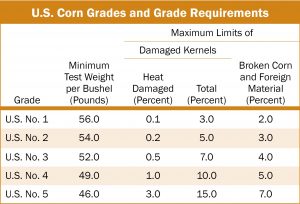Export Cargo Quality Highlights
The average aggregate quality of the corn assembled for export early in the 2018/2019 marketing year was better than or equal to U.S. No. 2 on all grade factors, and average moisture content was slightly higher than 2017/2018. Chemical composition attributes indicated slightly higher starch and slightly lower protein and oil concentrations than 2017/2018. The early 2018/2019 corn exports had lower stress cracks and higher whole kernels than 2017/2018. In addition, all of the samples’ test results for aflatoxin and deoxynivalenol (DON) or vomitoxin were below the U.S. Food and Drug Administration (FDA) action and advisory levels, respectively. Notable U.S. Aggregate quality attributes of the 2018/2019 export samples include:
Grade Factors and Moisture
- Same average test weight of 57.4 pounds per bushel (lb/bu) (73.9 kilograms per hectoliter (kg/hl)) as 2017/2018, indicating overall good quality, with 84.4% of the samples at or above the limit for U.S. No. 1 grade.
- Same average broken corn and foreign material (BCFM) (2.9%) as 2017/2018 and slightly lower than the 5YA1 and the maximum limit for U.S. No. 2 grade. BCFM predictably increased from 0.7 to 2.9%, as the crop moved from harvest through the marketing channel to export.
- Higher average total damage at export (2.6%) than 2017/2018 and the 5YA. Most (94.7%) of the samples were below the limit for U.S. No. 2 grade.
- Average heat damage was 0.0%, the sameas 2017/2018 and the 5YA, indicating good management of drying and storage of corn throughout the marketing channel.
- Slightly higher average moisture (14.5%) than2017/2018 and the 5YA.
Chemical Composition
- Slightly lower average protein concentration (8.5% dry basis) than 2017/2018 but same as the 5YA.
- Slightly higher average starch concentration (72.3% dry basis) than 2017/2018 but lower than the 5YA.
- Slightly lower average oil concentration (4.0% dry basis) than 2017/2018 but slightly higher than the 5YA.

Physical Factors
- Lower average stress cracks (7%) than 2017/2018 and the 5YA. The majority of the export samples (88.5%) had less than 15% stress cracks, which should result in relatively low rates of breakage during handling.
- Lower average stress crack index (16.2) than 2017/2018 and the 5YA. The lower stress crack index and stress crack percentages in 2018/2019 than in 2017/2018 may be due, in part, to lower average moisture at the 2018 harvest than at the 2017 harvest.
- Higher average 100-kernel weight (36.17 grams) than 2017/2018 and the 5YA, indicating heavier kernels in 2018/2019 than last year and the 5YA.
- Same average kernel volume (0.28 cubic centimeters (cm3) as 2017/2018 and the 5YA.
- Slightly higher average true density (1.288 grams per cubic centimeter (g/cm3) than 2017/2018 and the 5YA.
- Higher average percent of whole kernels (85.2%) than 2017/2018 but lower than the 5YA.
- Average horneous (hard) endosperm of 82%, slightly higher than 2017/2018 and the 5YA, indicating slightly harder corn.
Mycotoxins
- All of the export samples tested below the U.S. FDA action level of 20 parts per billion (ppb) for aflatoxins. A higher proportion of the export samples had no detectable levels of aflatoxins than in 2017/2018.
- 100% of the corn export samples tested below the 5 parts per million (ppm) FDA advisory level for DON (same as 2017/2018). There were slightly fewer samples showing levels of DON below the Federal Grain Inspection Service (FGIS) “Lower Conformance Level” of 0.5 ppm in 2018/2019 than in 2017/2018.
